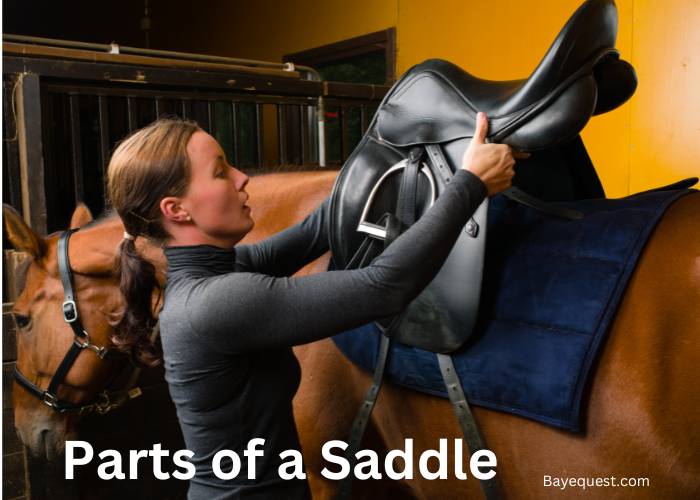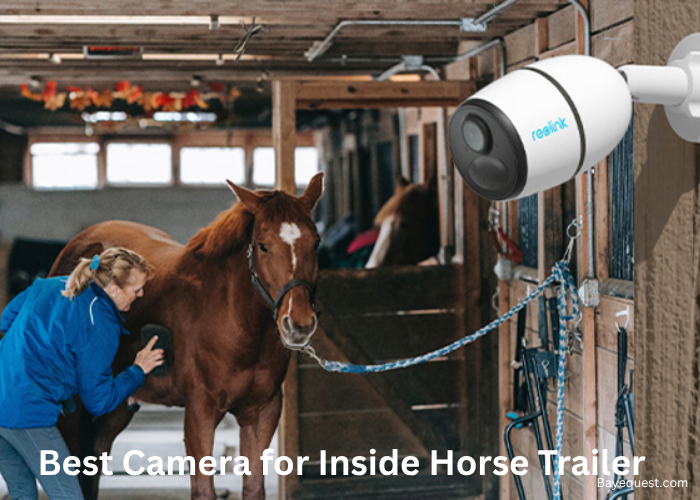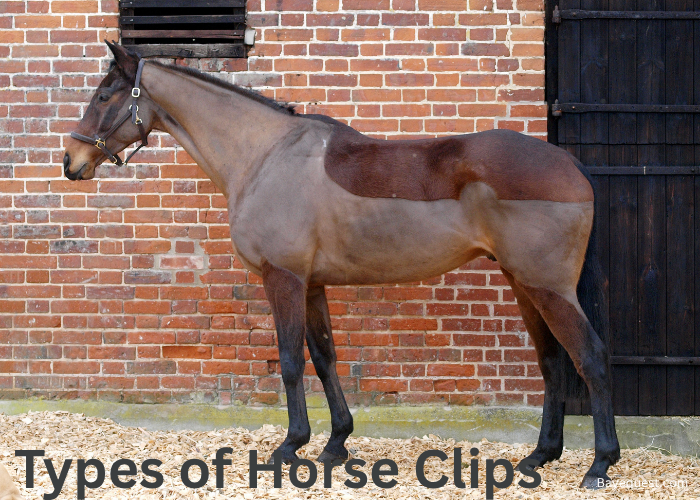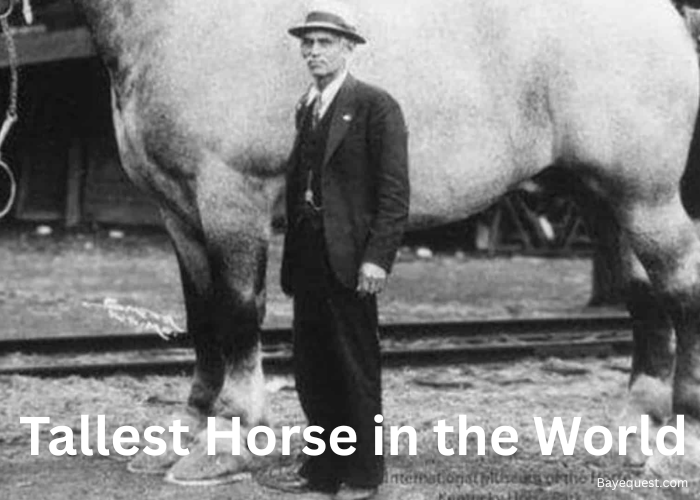A saddle is an essential piece of equipment for horseback riding. It provides comfort and support for both the rider and the horse.
Each part of a saddle plays a specific role in ensuring safety, balance, and control during a ride.
Understanding these parts can help you choose the right saddle and care for it properly. From the seat to the stirrups, every detail matters.
In this blog, we will break down the different parts of a saddle and explain their purpose in simple terms.
What is a Horse Saddle?
A saddle is a seat for the rider of an animal, usually a horse. It helps you stay secure and comfortable while riding.
It’s designed to fit the horse’s back, balancing your weight without hurting the animal.
So, whether trotting on a trail or racing around a track, a good saddle makes all the difference.
Several types of horse saddles are tailored to different riding disciplines.
Western saddles, known for their durability and comfort, are ideal for long rides and ranch work.
On the other hand, English saddles are designed for jumping, dressage, and racing, offering closer contact with the horse for precise control.
Parts of a Western Saddle
Let’s explore the essentials of a Western saddle. We’ll look into each component that enhances rider comfort and horse performance.
Gullet
The gullet is the space between the saddle tree bars that sits right above the horse’s withers. It’s crucial for fit; it is too tight and it pinches; too wide and lacks stability.
A properly sized gullet allows freedom of movement and helps distribute the rider’s weight evenly across the horse’s back.
Saddle seat
The saddle seat is designed to support the rider’s weight over long periods comfortably.
It’s contoured to offer a balanced position, ensuring the rider can maintain control and posture without straining.
Seats vary in depth and cushioning, catering to different riding styles and preferences.
Seat jockeys
Seat jockeys are the smooth leather pieces under the rider’s thighs, providing a layer between the rider and the saddle rigging.
They help protect the rider’s legs from chafing and add an extra cushion, enhancing comfort during rides.
Rear billet strap
This strap is part of the saddle’s rigging, used to secure the back cinch to the saddle.
It helps stabilize the saddle, preventing it from shifting forward under the rider’s weight or during sudden movements.
Front cinch
The front cinch, or girth, is a crucial component that holds the saddle securely on the horse.
It wraps around the horse’s belly, just behind the front legs, fastening tightly to ensure the saddle does not slip or rotate during riding.
Back cinch
The back cinch connects to the rear billet straps and sits snug against the horse’s belly, providing additional stability.
It’s important in roping or mountain riding activities, where the saddle might otherwise lift at the back.
Saddle maker’s logo
Typically found on the fender or behind the cantle, the saddle maker’s logo not only brands the saddle but often indicates its craftsmanship quality.
Recognizing reputable brands can help you choose a durable and well-constructed saddle.
Latigo keeper
This small but vital leather loop holds the end of the latigo strap after it’s tightened around the cinch. It keeps the strap secure and tidy, preventing it from dangling or catching during the ride.
Saddle tree
The saddle tree’s foundation is a rigid frame that shapes the saddle and distributes the rider’s weight across the horse’s back.
Made from wood or synthetic materials, it’s covered in leather or rawhide for durability and form.
Saddle bars
These parts of the saddle tree lie against the horse’s sides.
They are designed to spread the rider’s weight and any load evenly over a larger area of the horse’s back, minimizing pressure points and increasing comfort for the horse.
Parts of an English Saddle
Let’s uncover the key parts of an English saddle. I’ll show you how each detail supports rider stability and control.
Saddle horn
English saddles do not feature a saddle horn. This is a characteristic component of Western saddles, used for roping and stability.
English riders rely on balance and the saddle’s overall design for support.
Stirrup leathers
Stirrup leathers are the straps that attach the stirrups to the saddle.
They can be adjusted to change the stirrup length, accommodating the rider’s leg length and ensuring proper riding posture.
Made of durable leather, they need regular conditioning to maintain flexibility and strength.
Stirrups
Stirrups provide a place for the rider’s feet while riding, aiding in balance and control.
They hang from the stirrup leathers and should be sized to fit the width of the rider’s boot to prevent the foot from slipping through or getting stuck.
Knee pads
Knee pads on an English saddle are soft, padded areas that cushion the rider’s knees against the saddle flap.
They help stabilize the rider’s position by providing grip and comfort, especially during jumps or fast riding.
Seat
The seat of the English saddle is designed to be comfortable and supportive, helping the rider maintain an effective and secure riding position.
It’s flat with a slight rise at the back, promoting balance and freedom of movement.
Saddle flap
The saddle flap is the large piece of leather under the rider’s leg that protects the leg from rubbing against the horse and the girth straps.
It also assists in channeling the rider’s aids to the horse effectively.
Pommel
The pommel is the front part of the saddle, slightly raised to provide stability and support.
It helps anchor the saddle and offers the rider a grip point, especially in disciplines like dressage, where precise movements are crucial.
Twist
The twist is the narrowest part of the saddle’s seat, located between the rider’s thighs.
Its width and shape affect rider comfort and leg position, influencing the ease with which a rider can maintain a deep seat.
Fender
Unlike Western saddles, traditional English saddles do not have fenders. Instead, they have saddle flaps that provide leg protection.
Fenders are more characteristic of Western riding gear.
Skirt
The skirt on an English saddle is minimal compared to its Western counterpart.
It consists mainly of the small leather area covering the stirrup bars and part of the tree to prevent rubbing.
Knee roll
It is positioned on the front of the saddle beneath the saddle flap.
The knee rolls help support the rider’s knee, providing stability and security, particularly in jumping disciplines.
Stirrup bar
The stirrup bar is a small, metal bar located under the skirt of the saddle.
It’s where the stirrup leathers are attached, allowing for easy adjustments and quick release if necessary for safety.
Keeper
The keeper is a small leather loop on the saddle that secures the end of the stirrup leathers, keeping them flat and neat against the saddle, preventing them from flapping or catching.
Grab straps
Also known as a “panic strap,” this is a short strap attached to the front of the saddle.
It offers beginners or inexperienced riders something to hold onto for balance in instability.
Girth straps
Also known as billets, these are the long leather straps that hang from the saddle and connect to the girth, securing the saddle on the horse.
They are designed to withstand significant tension and wear.
What is the Horn of a Saddle Called?
The horn of a saddle, commonly referred to as the “saddle horn,” is a distinct feature predominantly found on Western saddles.
This protruding part at the front of the saddle serves multiple practical purposes.
Traditionally, cowboys use it to secure a lasso when roping cattle, aiding in ranch work. The saddle horn also provides a stable handle for riders to grasp.
It offers extra support and balance during various activities, including quick turns and riding on rough terrain.
Its utility and iconic shape make the saddle horn an indispensable tool and a symbol of Western horseback riding.
What is a Gullet on a Saddle?
The gullet is a key saddle part found right beneath the pommel. It’s the gap that runs along the underside of the saddle, sitting above the horse’s withers.
A properly sized gullet is crucial because it prevents the saddle from pressing down on the horse’s spine.
It helps distribute the rider’s weight evenly across the horse’s back.
When choosing a saddle, make sure the gullet fits right for the health and happiness of both horse and rider.
Materials Used in Saddle Making
When making saddles, craftsmen choose materials that stand the test of time and comfort.
Leather is the star here—it’s durable, flexible, and ages beautifully. But not all saddles stick to tradition. Some use synthetic materials, which are lighter and often easier to care for.
Then, there’s the hardware—usually metal—for buckles and hooks that must be strong as they hold everything together.
Whether it’s a rugged trail or a sleek race track, the materials used in a saddle play a big role in how well it performs and lasts.
Maintenance and Care for Saddles
Taking good care of your saddle is key to extending its life and ensuring safety during rides.
Start with regular cleaning. Use a suitable saddle soap to remove dirt and sweat.
After cleaning, apply a conditioner to keep the leather soft and prevent cracking. For synthetic saddles, a simple wipe-down with a damp cloth might suffice.
Don’t forget about storage. Keep your saddle in a cool, dry place away from direct sunlight to avoid fading and drying out the material.
Hanging it on a saddle rack can help maintain its shape.
Lastly, regular inspections are crucial. Check for any signs of wear or damage, like loose stitching or worn-out straps, and address these issues promptly to avoid accidents.
Read more on how to clean saddles in our other guide.
How to Choose the Right Saddle
Choosing the right saddle is crucial for both comfort and performance. Here’s how to make the best choice:
1. Determine the discipline
Start by considering the type of riding you’ll be doing. Whether it’s dressage, jumping, trail riding, English or Western riding.
Different styles of saddles are designed to support the specific needs of each riding style.
2. Consider the fit for the horse
The saddle must fit your horse correctly. A poorly fitting saddle can cause discomfort or injury to the horse.
Have a professional saddle fitter assess your horse’s back to recommend the best size and style of saddle that fits well. (Read also: How to Fit a Saddle to a Horse.)
3. Consider your comfort
You’ll also need a saddle that fits you comfortably. The size and shape of the seat should allow you to sit naturally and maintain balance without straining.
Test different saddles if possible, focusing on the feel of the seat and stirrup position.
4. Material choices
Decide between leather and synthetic materials. Leather is traditional, durable, and ages well if cared for properly, but it can be more expensive and heavier.
Synthetic saddles are lighter, generally less expensive, and easier to maintain.
5. Quality and budget
Invest in the best quality you can afford. A good saddle is an investment that, with proper care, can last many years.
Consider reputable brands and read reviews to gauge long-term satisfaction.
6. Consult professionals
When in doubt, consult with more experienced riders, trainers, or a professional saddle fitter.
Their expertise can guide you in making a decision that ensures safety and comfort for you and your horse.
Interesting read: How to Measure a Horse for a Western Saddle.
FAQs
Why is there a hole in a Western saddle?
The hole in a Western saddle is called the gullet. It keeps the saddle off the horse’s spine. This helps spread the rider’s weight evenly and prevents pain or injury. It also allows the horse to move freely and improves airflow under the saddle.
How does a Western saddle differ from an English saddle?
A Western saddle is larger and heavier. It has a horn for securing ropes and a deep seat for comfort. An English saddle is smaller and lighter. It is made for activities like jumping or dressage. The main difference is their use—Western saddles are for long rides, while English saddles focus on sports and control.
Parts of a Saddle: Conclusion
And there you have it—the nuts and bolts of a saddle, broken down to the basics. Understanding each part not only boosts your knowledge but also enhances your rides.
So, the next time you saddle up, remember the roles each component plays.
Keep them well-maintained, and they’ll keep you riding smoothly and safely. Happy trails to you.








